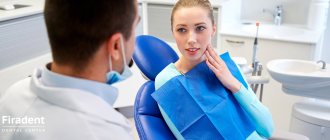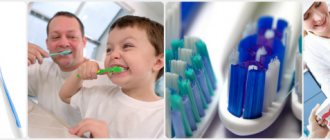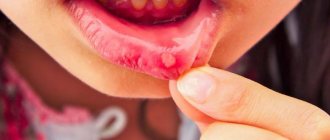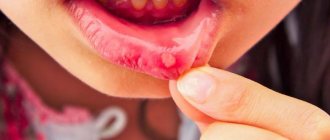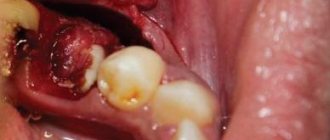Chronic stomatitis is a disease that is accompanied by repeated inflammatory processes of the oral mucosa. Many patients want to know what causes the development of chronic stomatitis. In the vast majority of cases, the development of this pathological condition is associated with a whole complex of various factors - both internal and external.
The most common form today is chronic aphthous stomatitis, which is diagnosed in 5% of cases among all diseases of the oral mucosa.
In our clinic you can get a free dental consultation!
Our doctors
18 years of experience
Baghdasaryan
Armen Evgenievich
Chief physician, dentist-orthopedist-therapist
Graduated from VSMA named after. N.N. Burdenko. Internship on the basis of MGMSU named after. A.E. Evdokimov in “General Dentistry”.
Clinical residency at the Moscow State Medical University named after. A.E. Evdokimov in “Orthopedics”.
More about the doctor...
5 years experience
Sadina
Ekaterina Vladislavovna
Dental therapist, surgeon
Penza State University Medical Institute, specialty “Dentistry”.
In 2016, she underwent professional retraining in the specialty “Therapeutic Dentistry” at the Moscow State Medical and Dental University named after A.I. Evdokimov.
More about the doctor...
8 years of experience
Arzumanov
Andranik Arkadievich
Dentist-orthodontist
Graduated from Moscow State Medical University. Internship - Moscow State Medical University at the Department of Orthodontics and Children's Prosthetics.
Residency at Moscow State Medical University at the Department of Orthodontics and Children's Prosthetics. Member of the Professional Society of Orthodontists of Russia since 2010.
More about the doctor...
Treatment of stomatitis
It is important to contact your dentist in a timely manner. Everything will depend on the disease and the causes of its occurrence. To cure infectious sources, you will need a complex of vitamins, immunomodulators, antibacterial, antifungal, and antiviral medications. They may also use products to help relieve pain and promote rapid healing.
If the inflammatory process appears due to an injury, then all you have to do is treat it and disinfect it. If the nature of the disease is toxic or allergic, then you need to eliminate the cause, and then cleanse the body.
When treating stomatitis, it is important not to consume hot drinks, food, sweet, salty, sour, spicy foods, and you need to follow a diet. If you have thrush, it is recommended to remove fermented milk products.
Causes
It is customary to identify various causes of chronic stomatitis in adults. They determine the form of the disease:
- The aphthous form can be caused by E. coli, streptococci, or a bacterial allergic reaction. There is a connection with autoimmune pathologies, as well as disruptions in the gastrointestinal tract and endocrine system;
- The candidiasis form develops with long-term use of antibacterial agents when infected with fungi of the genus Candida;
- The herpes form occurs due to the presence of the herpes simplex virus in the body with decreased immunity;
- Prosthetic chronic stomatitis in adults can be caused by various factors: an allergic reaction to the components from which the prosthesis is made; insufficiently good hygiene of dentures; frequent damage to the mucous membrane due to improperly fitted, installed or faulty dentures;
- Vincent's stomatitis can be provoked by spindle-shaped bacillus and Vincent's spirochete against the background of decreased immunity.
We cannot ignore the factors that provoke the development of chronic recurrent stomatitis. These include:
- unbalanced diet;
- taking medications;
- frequent stress;
- acute respiratory diseases;
- hypothermia;
- vitamin deficiency;
- irregular and insufficiently good oral hygiene;
- advanced stages of caries;
- ear, nose and throat infections.
Causes
To date, the exact etiology of aphthous stomatitis has not been fully identified. The main cause is considered to be a disruption of the immune system (uncontrolled activation of lymphocytes and neutrophils, which begin to destroy epithelial cells). At some point, the immune system ceases to recognize a number of components contained in saliva, which provokes the appearance of characteristic ulcers. However, this is far from the only reason. The aphthous form of stomatitis occurs under the influence of other factors:
- genetic predisposition
- immune system diseases
- gastrointestinal diseases
- neutropenia, Behcet's syndrome
- allergies to sodium lauryl sulfate, citrus fruits, dairy products, grains
- viruses and pathogenic bacteria (staphylococci)
- mucosal injuries
- avitaminosis
- pregnancy
- psychological disorders
Clinical manifestations
The symptoms of chronic stomatitis directly depend on the form of the disease
| Type of acute stomatitis | Clinical manifestations |
| Atrophic |
|
| Vincent |
|
| Herpetic |
|
| Prosthetic |
|
How to treat aphthous stomatitis
Treatment of aphthous stomatitis is the job of a qualified specialist. Self-medication is not worth it because even for a professional it is not always easy to establish the true cause of the onset and exacerbation of the disease. In general, treatment is carried out according to the following method:
- the use of medications against the ulcers themselves and to prolong remissions and prevent relapses
- the use of painkillers and necrolytic agents (to remove dead diseased tissue)
- treatment with antiseptic, anti-inflammatory and healing drugs
- referral for examination to identify concomitant and provoking diseases
- drawing up a dietary diet (necessarily excluding hot, spicy and rough foods, as well as allergens).
Aphthous stomatitis occurs not only in adults, but also in children. Moreover, the method of its treatment in children does not differ from procedures in adults. The children's diet is additionally enriched with sources of vitamins B and C, and immunostimulating drugs are prescribed.
Diagnostics
The most important role in diagnosing a disease is to establish the causes of its development. It is they who determine the future tactics of treating inflammatory processes. In order to achieve the desired result, make a smear from the surface of the ulcer, and also carry out:
- study of ulcerative lesions;
- bacteriological examination;
- checking the plasma chain reaction of scrapings.
Symptoms
It is worth knowing about other manifestations of stomatitis. The most common signs include:
- Initially, the symptoms may resemble a standard cold (headache, joints, muscles, bones hurt, temperature may rise, sometimes a runny nose, pain in the throat);
- the lymph nodes become enlarged, it’s even painful to touch them;
- due to pain, a person or child may completely refuse to eat, and apathy is observed;
- stomatitis can be caused by staphylococcus or streptococcus, and the disease appears against the background of a sore throat. Then the person has purulent discharge, thick saliva containing mucus, and an unpleasant odor from the mouth;
- The soft tissues of the cheeks and lips are damaged, tartar appears, cracks, and the mucous membrane becomes very dry. This is noted in those patients who smoke;
- in the case of a fungal infection as a pathogen, the surface of the mucous membrane is usually covered with a cheesy white coating;
- in the case of an advanced form of stomatitis, rashes appear even on the skin;
- if the disease was provoked by viral agents, then ulcerative and aphthous lesions may also affect other parts.
Treatment
In order to eliminate chronic stomatitis, professional oral hygiene, sanitation of infectious foci and local applications are carried out. As for the specific tactics used for one form or another of the disease, they are presented in the table below
| Type of acute stomatitis | Treatment options |
| Vincent |
|
| Herpetic |
|
| Traumatic |
|
Modern methods of treatment of chronic recurrent aphthous stomatitis
O. A. Uspenskaya, Candidate of Medical Sciences, Associate Professor of the Department of Therapeutic Dentistry of Nizhny Novgorod State Medical Academy, Nizhny Novgorod.
One of the most common diseases of the oral mucosa (from 5 to 60%) is chronic recurrent aphthous stomatitis (CRAS), it accounts for 90% of all violations of the integrity of the mucous membrane encountered in dental practice - this is a chronic inflammatory disease of the oral mucosa, characterized by the occurrence of aphthae (ulcers) and occurring with periodic exacerbations and remissions.
Damage to the oral mucosa in the form of recurrent aphthae is mentioned in the works of Hippocrates. But only in 1894 was chronic recurrent aphthous stomatitis described by Ya. I. Trusevich as an independent disease. In the same year, Jacobi reported on such a lesion of the oral cavity under the name “stomatitis neurotica chronica” (chronic necrotizing stomatitis). The first description of the ulcerative process on the oral cavity was made by Setton in 1911. R. A. Baykova, M. I. Lyalina, N. V. Terekhova in 1975, based on an analysis of clinical and morphological manifestations, identified 6 clinical forms of CRAS.
Despite the variety of studies conducted in our country and abroad, the etiology and pathogenesis of the disease remain the subject of much debate. It has not been conclusively established which factors dominate in the pathogenesis of CRAS and which predispose to the disease. A certain role in the emergence and development of HRAS belongs to hereditary and constitutional factors [O. F. Rabinovich, I. M. Rabinovich, E. L. Panfilova, E. V. Vakhrushina, 2010].
The causes of the disease also include dysfunction of the gastrointestinal tract, respiratory infections, functional disorders of the central and autonomic nervous system, hypovitaminosis B1, B2, B6, B12, C, lack of iron, zinc, chronic inflammatory diseases of the nasopharynx (otitis, rhinitis, tonsillitis ). I. M. Rabinovich et al. (1998) believe that the etiology and pathogenesis is based on the autoimmune theory.
The question of the allergic genesis of recurrent aphthous stomatitis is widely discussed. Allergens can include food products, toothpastes, dust, worms and their waste products, and medicinal substances.
V. I. Lukashova, A. I. Rybakov et al. (1973-1977) a significant role in the pathogenesis of the disease is assigned to bacterial and viral allergies. Endocrine disorders play a certain role in the development of the disease. In addition, in patients suffering from CRAS for more than 5 years, there is a true immunodeficiency with a decrease in the number and functional activity of T-lymphocytes, dysimmunoglobulinemia and inhibition of the phagocytic function of neutrophils, interleukin-dependent immunodeficiency [Spitsina V.I., 2006].
Treatment of CRAS still remains a pressing problem and is a difficult task due to the fact that the etiology and pathogenesis of the disease have not been fully elucidated.
An important measure to ensure the success of treatment is a clinical and immunological examination of the patient in order to identify and then treat concomitant diseases, primarily diseases of the gastrointestinal tract and liver, infectious allergies, vitamin deficiency, disorders of the central and autonomic nervous system, etc. Particular attention should be paid to identifying dental diseases and their treatment. An important place in the treatment of CRAS is given to diet - the exclusion of hot, spicy, rough foods, strong alcoholic drinks and smoking [Borovsky E.V., Mashkilleyson A.L., 2001]. There is also evidence of the effectiveness of a gluten-excluding diet [Nolan A., Lamey P., 1991].
Currently, in the complex therapy of aphthous stomatitis, a special place is given to means of general action.
The choice of therapeutic agents is based on the need to influence different stages of pathogenesis. Thus, when hypersensitivity to bacterial allergens was detected in patients with CRAS, a number of authors [Borovsky E.V., Mashkilleyson A.L., 2001; Rybakov A.I., Banchenko G.V., 1978] proposed to carry out specific desensitization with this allergen, which is administered intradermally, starting with very small (0.001 ml) doses. If the body is sensitive to 2 or more allergens at once, small doses of a mixture of several allergens in equal dilutions were prescribed. However, the effect was not always observed. This is probably due to the lack of precise diagnostic criteria. In the treatment of severe forms of CRAS (scarring and deforming), corticosteroid drugs (prednisolone, dexamethasone) were used, which have anti-inflammatory, desensitizing and antiallergic effects [Altenburg A., 2007; Boldo A., 2008]. Corticosteroid drugs are used in the form of injection solutions, tablets, and ointments.
However, when using corticosteroids, side effects are possible: the development of Cushing's syndrome, increased blood pressure, hyperglycemia, increased excretion of potassium from the body, etc. All this leads to limiting the use of this group of drugs and the search for new methods of treating ASD.
Studying the clinical and immunological status of the patient is one of the important factors ensuring the success of treatment for CRAS. Due to the frequent detection of immune imbalance in patients, it is considered justified to include drugs with immunocorrective properties in the complex treatment of CRAS. Based on the data on impaired reactivity of the body in CRAS, drugs that increase the activity of nonspecific resistance factors, histoglobulin, prodigiosan, lysozyme were used in complex therapy [Lukinykh L. M., 2000; Rabinovich I.M., Banchenko G.V., Bezrukova I.V., 1997]. These drugs stimulate phagocytosis, indirectly affect antimicrobial factors, and stimulate reparative processes in the body.
Numerous literature data on the use of the immunocorrective drug levamisole (Decaris) are contradictory. Some authors note a good therapeutic effect, others completely deny it. This contradiction is apparently associated with the dual effect of levamisole: small doses have an immunostimulating effect, while large doses act as immunosuppressants. Thus, the assessment of the therapeutic effectiveness of levamisole depends both on the initial state of the patient’s immunological reactivity and on the dose of the drug used [Rabinovich O.F., Rabinovich I.M., Panfilova E.L., Vakhrushina E.V., 2010]. In 1991, N.V. Terekhova, V.V. Khazanova, E.A. Zemskaya and others used the drug T-activin. In immunodeficiency states, the drug stimulates the production of lymphokines, including interferon, restores the functional activity of T-killers, as well as a number of other indicators of the state of the immune system. Clinical and laboratory studies have shown that T-activin is quite effective in the treatment of patients with permanent forms of CRAS.
Of particular interest are the studies of V. A. Vinogradov, M. I. Titov, M. G. Moshnyaga (1991) on the use of dalargin, which has immunomodulatory properties, normalizes the proliferative response of human lymphocytes and affects rosette formation. It was also noted that with intramuscular administration of dalargin, in addition to stopping the inflammatory process in the oral cavity and stimulating the process of aft epithelization, the drug had a pronounced analgesic effect [Maksimovskaya L.N., 1995].
With the advent of the new domestic drug Galavit in 1997, a study of its effectiveness in the treatment of CRAS began. Galavit is an immunomodulator, changes the functional activity of macrophages and regulates the synthesis of cytokines, a low-toxic drug that does not have teratogenic, mutagenic or immunotoxic effects and does not give an allergenic effect [Sokhov S. T., Tsvetkova A. A., Askamit L. A., 2009] . There is data on the use of Galavit injections in the treatment of periodontitis and diplen films with Galavit in the erosive and ulcerative form of LLP.
We studied the action of Galavit in the complex treatment of CRAS. Under observation were 13 people suffering from Mikulicz's aphthosis aged from 18 to 43 years (8 women and 5 men), who were prescribed sublingual lozenges containing 25 mg of the drug. 10 days daily, 4 tablets per day, in the next 20 days - 4 tablets per day every other day (full course - 30 days) [Sokhov S. T., Tsvetkova A. A., Tereshchenko, 2007]. The comparison group included 6 people suffering from CRAS, whose treatment regimen excluded the use of Galavit.
To assess the effectiveness of the therapy, we studied changes in a number of basic clinical signs of this disease (presence of aphthae, erythema, pain, bad breath, impairment of general condition), as well as changes in indicators of local immune defense of the oral cavity. When Galavit was included in the complex of treatment measures, all patients showed positive dynamics by the 6-7th day (decrease in the intensity of inflammation, decrease in pain, active epithelization of elements). By the 9-10th day, almost complete epithelization of the elements and clinical recovery of the patients was observed, while in the comparison group healing occurred by the 13-14th day.
With further monitoring of patients taking Galavit over the next 12 months. there were no relapses. Whereas in 2 people from the comparison group a relapse occurred after 6 and 7 months. after the treatment.
When studying mixed saliva, there was a positive trend in changes in the concentration of immunoglobulin A while taking Galavit, in contrast to the comparison group, which echoes the studies of S. T. Sokhov, A. A. Tsvetkova, L. A. Aksamit (2009).
Thus, the inclusion of the drug Galavit in the complex of treatment measures for patients suffering from CRAS can significantly shorten the recovery time and reduce the likelihood of relapses.
Another treatment method for CRAS is plasmapheresis. In 1997, O. V. Borisova, N. L. Elkova and others proved that the use of plasmapheresis improves the general condition of patients, reduces the time of aft epithelialization, achieves long-term remissions, and positive dynamics of homeostasis indicators. In addition, the use of vitamins in the complex treatment of patients with CRAS is recommended.
One of the links in complex therapy is local treatment. First of all, this is the sanitation of the oral cavity, the elimination of traumatic factors and foci of chronic infection, the use of painkillers, antimicrobial, anti-inflammatory and keratoplasty agents. Microbiological examination of material from SOR in patients with ASD reveals significant changes in the microbiocenosis, expressed in a change in the ratio of representatives of normal and pathogenic microflora. To suppress pathogenic microflora, L. M. Lukinykh suggests using a 0.02% solution of furatsilin, a 0.02% solution of ethacridine lactate.
I. M. Rabinovich et al. They use a 0.12% solution of chlorhexidine, as well as the Tantum Verde solution, which has not only disinfectant but also pronounced analgesic properties.
One of the most effective antiseptic and anti-inflammatory drugs is Metrogyl Denta.
The drug has a pleasant, refreshing mint taste and is applied to the affected areas 2 times a day. The combination of metronidazole and chlorhexidine, which effectively suppresses aerobic and anaerobic microorganisms, is proposed by S. Yu. Strakhova and L. N. Drobotko.
To accelerate the time of epithelization of pathological elements in CRAS, 5% methyluracil ointment, caratoline, and rosehip oil are used. One of the effective means of promoting epithelialization of aphthae is Solcoseryl dental adhesive paste containing solcoseryl and the local anesthetic polidocanol. This dosage form also provides an analgesic effect. Due to its properties, the drug is adhesively fixed to the oral cavity, providing a prolonged therapeutic effect. Apply a thin layer 3-5 times a day to the mucous membrane (previously dried with cotton wool or a paper napkin) and moisten with water. When compared with Mundizal gel in studies by I.M. Rabinovich and G.V. Banchenko (1998), Solcoseryl dental adhesive paste turned out to be more effective.
To remove necrotic plaque from the surface of lesions, it is recommended to use proteolytic enzymes (trypsin, chymotrypsin). Modern enzyme preparations include immobilized enzymes - stomatozyme and imozymase [Epeldimova E. L., 2005]. To increase the effectiveness of local effects on the elements of the lesion, L. M. Lukinykh (2000), R. V. Ushakov, V. N. Tsarev et al. (2002) proposed the use of soluble medicinal films, the active substance of which is in one way or another connected with dense carrier. The advantage of films is that a constant concentration of the active substance in the pathological zone is maintained for a long time, the area of influence of a particular substance is limited to the affected area, and thanks to the strong fixation of the film, the affected area is protected. These films contain corticosteroid, antibacterial, epithelializing, immunomodulating and other drugs.
L. F. Sidelnikova, I. G. Dikova considered it appropriate to include in the complex treatment regimen for chronic recurrent aphthous stomatitis the local immunomodulating drug Imudon, which was prescribed locally, one tablet 6-8 times a day for 10-15 days (depending on the severity of the process) followed by preventive courses every 4–6 months, one tablet six times a day for 10 days. A positive result was achieved 1.5–2 days faster than in patients who did not take the drug.
The main clinical effect was the prevention of relapses of the disease, and when they occur, they occur in a milder form.
At the same time, studies conducted by V. Yu. Orishchenko, T. N. Strelchenya showed that preliminary general stimulation of the immune system with methyluracil followed by local antigenic stimulation with Imudon is a more effective immunotropic prevention of recurrence of CRAS. Patients are recommended methyluracil 0.5 x 3 times a day for 20 days. From the 10th day, Imudon is added, 8 tablets per day, for a week. Preventive courses are prescribed in the autumn-spring period at the stage of remission.
The HRAS group of topical treatments includes a large number of medicinal plants. Herbal remedies rarely cause unwanted side effects, are non-toxic and are well tolerated by patients regardless of age. Considering their harmlessness, they are recommended for long-term use [Khazanova V.V., 1993; Rabinovich I.M., Zemskaya E.A., 1996].
To increase the nonspecific reactivity of the body, the herbal medicine Svitanok has proven itself well. A combined preparation of plant origin, Elekasol (calendula flowers + chamomile flowers + licorice roots + string grass + sage leaves + eucalyptus leaves) has an antimicrobial and anti-inflammatory effect, stimulates reparative processes.
It is used topically - in the form of irrigations, applications, for rinsing, for 5-7 days simultaneously orally and topically 2-5 times a day.
Phytodent preparation based on plant raw materials (alcohol tincture 1:10) from plant raw materials (calamus rhizomes - 0.2 g, calendula flowers - 0.15 g, nettle leaves - 0.1 g, chamomile flowers - 0.1 g, fruits Japanese sophora - 0.2 g, celandine herb - 0.15 g, rose hips - 0.1 g) has anti-inflammatory, analgesic, deodorizing and fungicidal effects, is well absorbed by the oral mucosa, in addition, enhances the effect of anti-inflammatory and analgesic agents . The drug is diluted with water and used for rinsing, washing and irrigation; as well as oral baths (3-5 times a day for 2-5 minutes).
In the complex treatment of CRAS, physiotherapy is also used, aimed at activating the adaptive and reserve capabilities of the body. One of the effective physical methods is laser therapy. A. A. Prokhonchukov et al. (2000) to relieve inflammation and accelerate the healing processes of the mucous membrane, laser irradiation was performed using the “Optodan” apparatus.
To increase the effectiveness of laser radiation, combined pharmaco-phototherapeutic methods are used - photophoresis of drugs.
Thus, photophoresis of oxolinic, methyluracil, heparin, hydrocortisone, and tetracycline ointments has proven itself well in the treatment of patients with CRAS [Prikuls V.F., 2000; Ushakov A. A., 1996].
To prevent exacerbations of HRAS, T. S. Chemikosova (2003) recommends oxymethacyl (pyrimidine derivative) for immunocorrection - 1.5 g per day for 1 month. And also 6 sessions of ultraphonophoresis with a 10% doxylan solution in pulse mode for 2-3 minutes. followed by applying 10% doxylan ointment to the erosions.
In recent years, non-drug treatment methods, in particular hyperbaric oxygen therapy (HBO), have become increasingly widespread in various fields of medicine. In the treatment of CRAS, HBO therapy produces pronounced anti-inflammatory, decongestant and immunocorrective effects, reducing the period of epithelization to 5-10 days [Spitsina V.I., Savchenko Z.I., 2002].
Hirudotherapy is widely used.
Moreover, the latter can be used both as a therapeutic (when aphthae appear) and as a preventive (during the interictal period) procedure. Hirudotherapy procedures should be preceded by thorough sanitation of the oral cavity (treatment of carious teeth, periodontal diseases, removal of dental plaque, etc.). When treating dental aphthosis, 1-2 leeches are placed on the area of aphthosis; when carrying out preventive procedures, they are placed on the places where aphthae usually appear.
In conclusion, it should be noted that at present there is no single treatment for CRAS that leads to a complete cure. Existing complex treatment methods help reduce the severity of the disease, expressed in lengthening the period of remission, reducing the period of epithelization of pathological elements, reducing their number and size. To achieve lasting results in the treatment of ASD, it is necessary to periodically repeat courses of complex therapy. The choice of optimal methods of general and local therapy should be based on an individual approach to each patient.
It is necessary to take into account concomitant somatic diseases, causative factors, the state of immunological reactivity, the severity of the disease, and the stages of development of lesions.
Prevention mainly consists of identifying and treating diseases of the gastrointestinal tract, nervous, endocrine systems, etc., as well as eliminating foci of chronic infection, including in the oral cavity. Systematic oral care is important.
Strict adherence to work and rest schedules, as well as diet, is necessary. Article provided by the magazine “Review. Dentistry"
Where to contact?
You can get treatment for chronic stomatitis at the Good Hands dental clinic. Our specialists are well aware that frequent relapses of the disease can reduce the patient’s quality of life and can provoke the development of periodontitis and benign and malignant oral tumors. They use individual treatment tactics that allow you to achieve good results, make the treatment effective and painless. You can schedule a free consultation with us and find out all the necessary information right now by filling out an application on our website or calling us by phone.
Causes of stomatitis
The most common causes of stomatitis include:
- diseases of the gastrointestinal tract and oral cavity;
- consequences of chemotherapy;
- unbalanced and irregular nutrition;
- lack of vitamins in the body;
- injuries and burns of the mucous membranes of the oral cavity or gums;
- complication of oncological pathologies;
- hormonal imbalance;
- alcohol abuse and smoking;
- penetration of pathogenic microorganisms onto injured mucous membranes of the mouth;
- various diseases that occur in a chronic form;
- lack of oral hygiene or use of low-quality toothpastes and brushes;
- prolonged or incorrect use of any medications.
Another factor is unfavorable environmental conditions. According to statistics, people living in megacities get sick more often than those living in areas remote from polluted cities.
